Recent Articles
Popular Makes
Body Types
2018 Toyota Prius Prime Road Test and Review
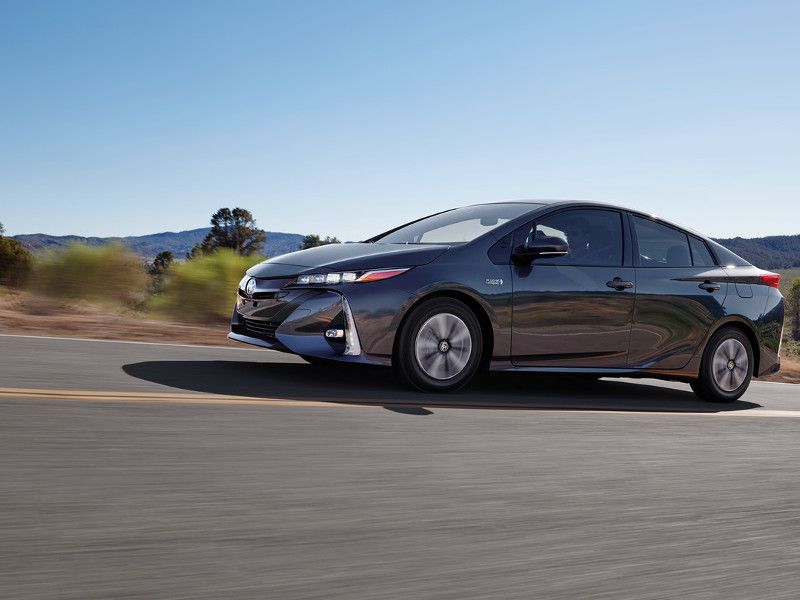
2018 Toyota Prius Prime Advanced ・ Photo by Toyota
In the world of hybrids, the undisputed king is the Toyota Prius. Now in its fourth generation, the Prius basically invented the hybrid class when it first debuted in 2000 and it has been the best-selling hybrid in America ever since.
Today Toyota offers the Prius in three distinct models: the subcompact Prius C, the best-selling Prius hatchback, and the Prius Prime, which is a plug-in hybrid. Introduced in last year, the Prius Prime is the same size as the standard Prius hybrid and it competes with the Chevrolet Volt and plug-in hybrid versions of the Honda Clarity, Kia Niro Plug-In, and Hyundai Ioniq. Many buyers are turning to plug-in hybrids because they offer the best of both worlds: A fully charged plug-in hybrid can be driven emissions-free on pure electricity like an electric car, but with the help of a small gasoline engine, they can be refueled at any gas station for extra range.
Less Expensive than a Chevy Volt
Toyota offers the 2018 Prius Prime in three trim levels: Plus, Premium, and Advanced. Prices start at $28,220, including a $920 destination and handling fee, for the Plus and climb to $34,220 for the Advanced model like our test vehicle. Unlike Toyota’s hydrogen-powered Mirai, the Prius Prime is available in all 50 states and can be purchased rather than just leased.
The Prius Prime's battery pack is also large enough that buyers may qualify for a $4,500 federal tax credit and possibly some state tax benefits. A Chevrolet Volt starts around $35,000, but because of its larger battery pack, it’s eligible for a $7,500 federal tax break. Both cars can be driven in California’s HOV lanes with a single occupant. The front-wheel drive Prius Prime uses a 1.8-liter four-cylinder engine making 95 horsepower in combination with a small electric motor and a lithium-ion battery pack adding an additional 26 hp for a total of 121 hp.
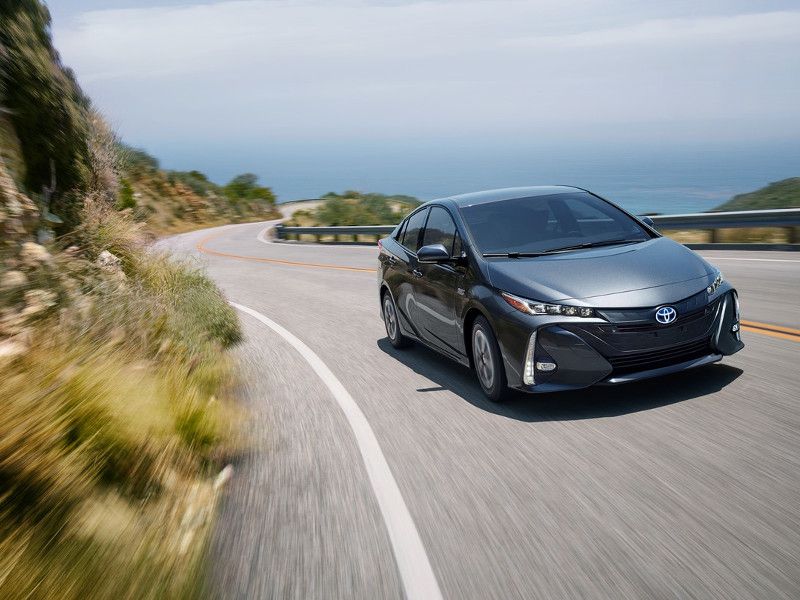
Photo by Toyota
Runs on Gasoline and/or Electricity
There are two ways you can fuel the 2018 Toyota Prius Prime. The first is with good old gasoline. The vehicle has an 11.3-gallon gas tank, just like a traditional car. But you can also charge its batteries by plugging it into a 240-volt or 120-volt outlet. And the process couldn’t be easier. It’s like plugging in your phone. Every Prius Prime comes with a 120v charge cord, which plugs into a port on the vehicles right rear quarter panel behind a small trap door. Pop open the door and insert the plug. That’s all there is to it.
On a standard household 120v outlet, charging takes about five and half hours, while a 240v dedicated car charger cuts that to about two hours. Prius Prime buyers also receive access to ChargePoint, the world’s largest public charging network with thousands of charging spots, 60 percent of which are free.
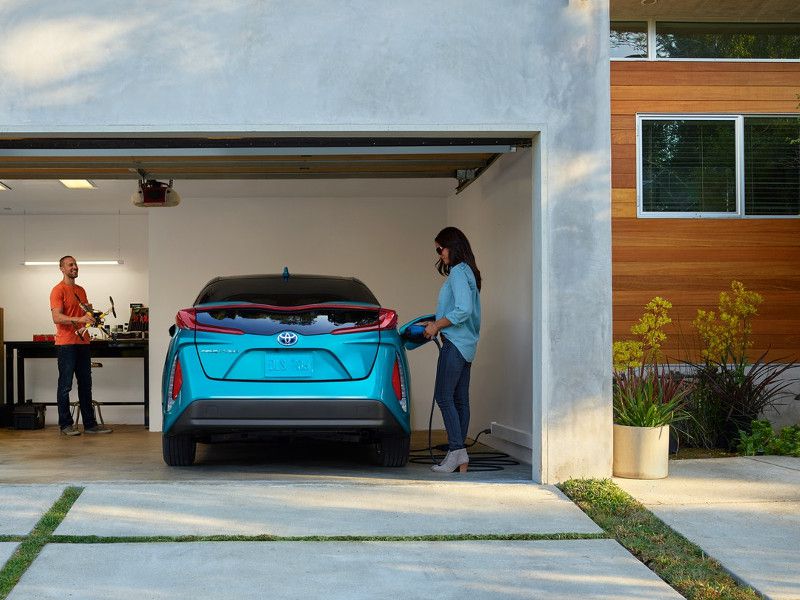
Photo by Toyota
640 Miles of Total Range
With its batteries fully charged, the Prius Prime functions like an EV, running on electricity alone for the first 25 miles or so. When that charge is depleted, it goes into hybrid mode — creating energy with both electricity and the burning of the gasoline-fed to its internal combustion engine. Total range is about 640 miles, which means you can drive the Prius Prime from Los Angeles to Las Vegas and back without plugging in or gassing up.
The EPA rates the 2018 Prius Prime fuel efficiency at 133 MPGe in EV mode and 55 mpg city and 53 mpg on the highway on regular fuel in hybrid mode. That makes it one of the most fuel-efficient vehicles in the world. The incredible part is how seamlessly it all works. The Prius Prime’s Power Control Unit decides when to use the battery’s stored energy and when to fire up the gas engine for additional power and range.
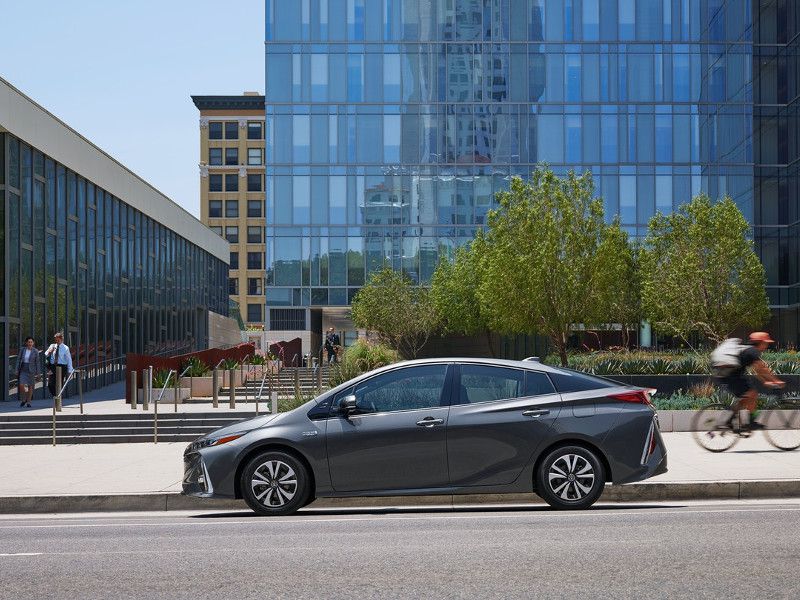
Photo by Toyota
Looks Different from a Regular Prius
Toyota’s styling has gotten wild over the last few years, and the 2018 Prius Prime is one of its most daring designs. It’s the same size as a standard Prius hybrid, with 182.9-inch length and 106.3-inch wheelbase, and it shares that model’s hatchback silhouette, but Toyota’s designers have given the Prius Prime is own distinct look.
Its wild front and rear fascias are all its own, as are its unique ultra-low profile quad LED headlamps. It’s extremely aerodynamic with a very slippery .25 coefficient of drag, and its automatic grille shutters close to help cheat the wind when airflow to the radiator isn’t needed. To save weight and boost efficiency, Toyota made the Prius Prime's hood out of aluminum and its rear hatch from carbon fiber. That rear hatch is also part of a radical rear view Toyota calls a “dual wave” rear window, which works with the Prime’s full-width LED taillamp design to create a look that’s truly unique.
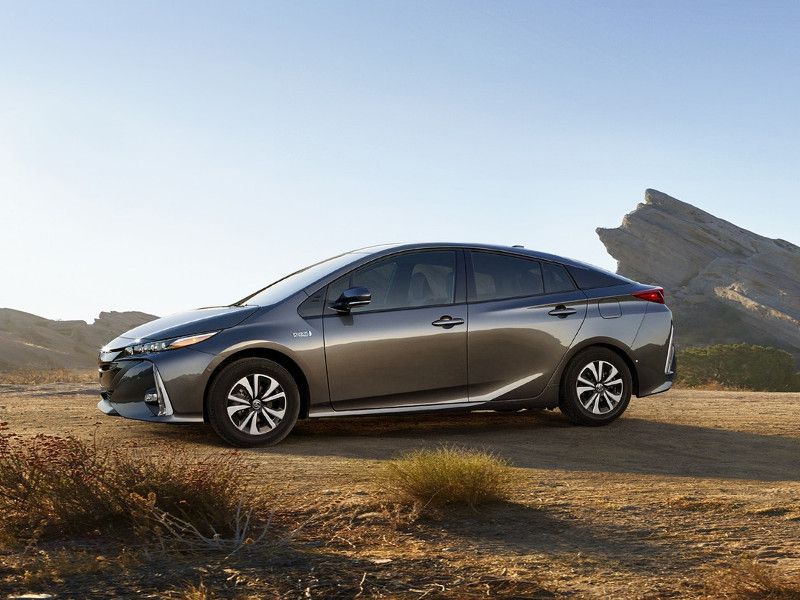
Photo by Toyota
Futuristic Interior
Like its exterior, the interior of the 2018 Toyota Prius Prime is right out of the future with center mounted instrumentation and — except on the base trim — a massive 11.6-inch touchscreen similar to the design pioneered by the Tesla Model S. The shifter is little nub that pokes out from the dashboard, and you put the transmission in Park with a button.
Visibility is outstanding, and the seats in our test vehicle, which Toyota has lowered for a more sporty driving position, were extremely comfortable. One notable change from the standard Prius is the Prime’s seating capacity. This is a four-seater, while the standard Prius seats five. This is an unfortunate consequence of fitting in the Prime’s larger battery pack.
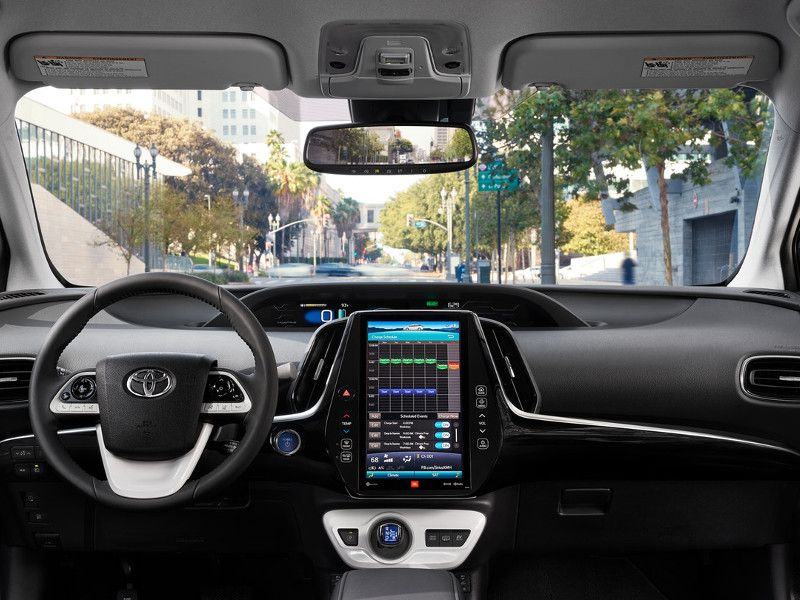
Photo by Toyota
Plenty of Cargo Capacity
Despite its compromised seating capacity, Toyota has fortified the Prius Prime’s family-friendly interior with well-thought-out and generous storage spaces. The center console bin and door pockets are large, and there’s an additional open bin on the console to store you phone. The two front-seat cupholders are also large, and they’re well-placed so tall drinks don’t interfere with any of the switchgear. Rear passengers also get a couple of cupholders on a center console.
Behind the rear seat is 19.8 cubic feet of cargo space, which is more than you get in some small suvs, but it’s slightly smaller than you get in the standard Prius and the Chevrolet Volt. Again, battery pack storage is the culprit. For more space, the Prime’s rear seat folds down in a 60/40 split, which opens up the cargo area significantly. The Prime’s cargo area is flat, so it’s easy to load and unload, and it has one of the lowest lift over heights in this class. A power-operated liftgate is not available on the Prius Prime, which is an unfortunate oversight on the model’s features list.

Photo by Toyota
Smooth as Silk
If I had to sum up the experience of driving the 2018 Toyota Prius Prime in one word, that word would be smooth. This five-door hatchback rides well, and its complex powertrain goes about its business with very little noise or vibration. It accelerates quietly and its continuously variable transmission never technically shifts gears, so there’s never any lurching or noticeable mechanical goings-on. Occasionally, if you’re paying close attention, you may notice the gas engine turning on and off, but that’s it.
That said, the Prius Prime isn’t exactly quick. With 0-60 mph acceleration in about 10 seconds, this is not a sport sedan, but around town it doesn’t feel slow. Just don’t pick any drag races with a Chevrolet Volt. You’ll lose badly. That model hits 60 mph in about 7 seconds. Overall, the Prius Prime is a comfortable and effortless vehicle to drive with precise steering and secure handling. I’m not sure I can call it fun to drive, but it is responsive and it cruises well on the highway.
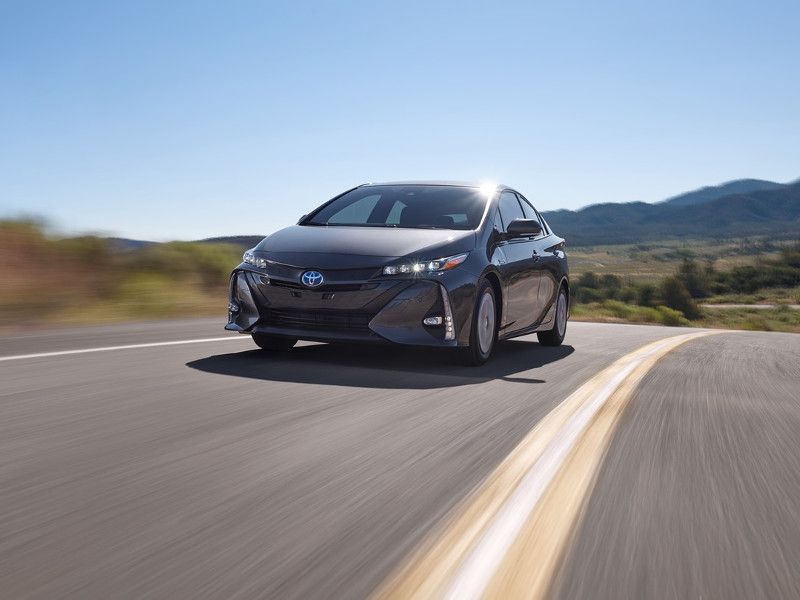
Photo by Toyota
High Safety Ratings
The Insurance Institute for Highway Safety has named the 2018 Toyota Prius Prime as one of its Top Safety Picks, and the National Highway Traffic Safety Administration has rated it five out of five stars. Every Prius Prime comes with Toyota Safety Sense, which includes a pre-collision system with pedestrian detection, a lane-departure warning with steering assistance, and all-speed radar cruise control.
Our Advance model also came with blind-spot monitoring, a rear cross-traffic alert, and a head-up display, as well as Safety Connect, which includes emergency assistance, a stolen vehicle locator, roadside assistance, and an automatic collision notifier. Parents with younger kids will appreciate the Prius’ easy-to-reach LATCH connectors in the rear seats and easily accessed upper tether anchors.
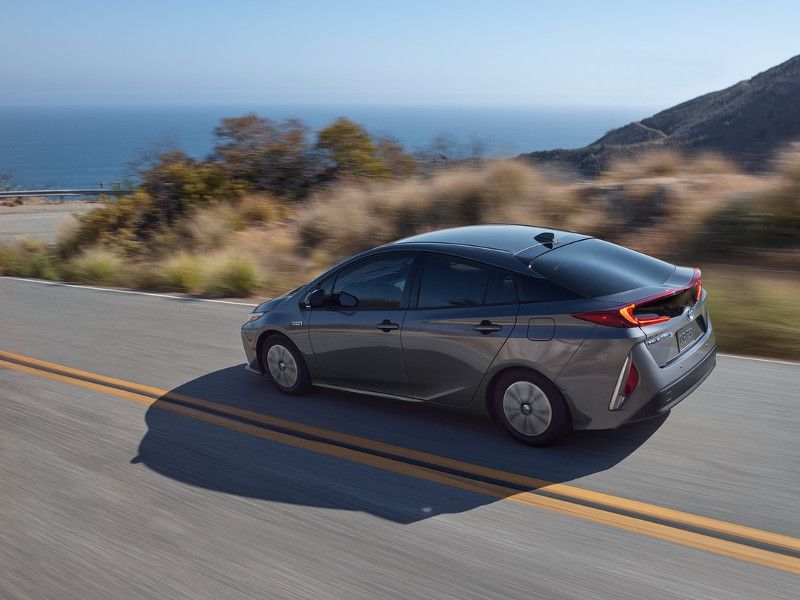
Photo by Toyota
Final Thoughts
Although the 2018 Toyota Prius Prime is less expensive than its main rival, the Chevrolet Volt, it does cost about $4,000 more than a comparable Toyota Prius hybrid. And that makes the plug-in Prime a tough sell. The standard Prius is rated at 54 mpg in the city and 50 mpg on the highway, so it’s almost as efficient as the Prime. Drive the Prime in EV mode only, limiting your range to around 25 miles, and you’ll save enough on gasoline to recoup that four grand eventually — but it’ll take a couple of lifetimes.
That said, if you’re sold on the plug-in technology and you’re looking for a reliable family-friendly ride with the highest possible efficiency and safety ratings, the 2018 Toyota Prius Prime checks all the right boxes.
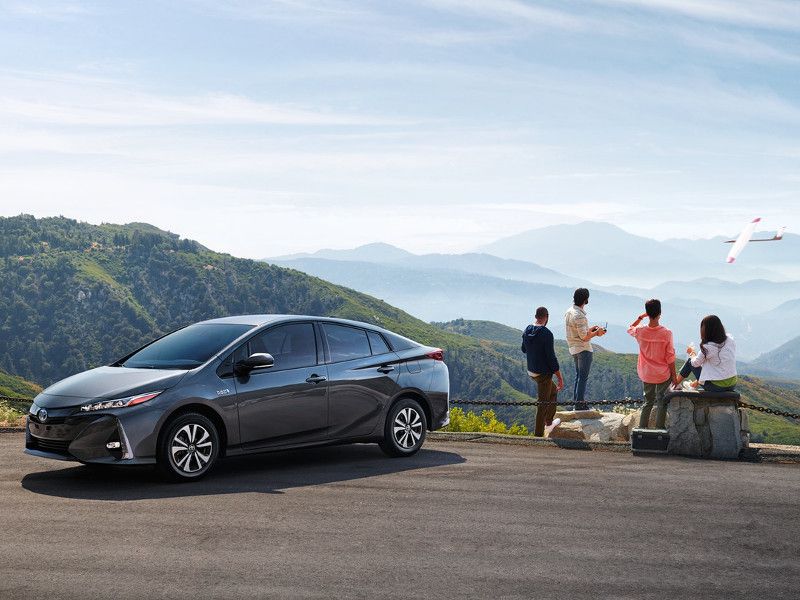
Photo by Toyota